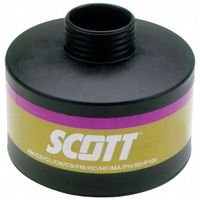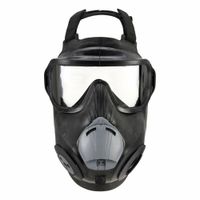Call +(254) 703 030 000 / 751 483 999 / 721 704 777
- Home
- Security
- Military Tactical Public Security Equipment
- Clothing Protective Equipment For Military Ems Law Enforcement
- Tactical Response Gas Masks Replacement Cartridges
.....Read More
Frequently Asked Questions
What are the best tactical response gas masks for military use?
1. **Avon Protection C50**: Known for its versatility and comfort, the C50 offers a high level of protection against CBRN threats. It features a panoramic visor for a wide field of vision and is compatible with a range of filters and accessories.
2. **MSA Millennium**: This mask is widely used by military and law enforcement. It provides excellent protection against chemical, biological, radiological, and nuclear threats. The flexible lens and comfortable fit make it suitable for extended wear.
3. **3M FR-7800B**: Designed for first responders and military personnel, this mask offers a high level of protection and comfort. It is compatible with various communication systems and has a durable silicone facepiece.
4. **Dräger X-plore 6300**: Known for its affordability and reliability, this mask provides effective protection against a wide range of hazardous substances. It features a robust design and is easy to maintain.
5. **Scott Safety General Service Respirator (GSR)**: Used by the UK military, the GSR offers advanced protection and comfort. It has a twin-canister design for improved breathing resistance and a drinking system for hydration.
6. **MIRA Safety CM-6M**: This mask is popular for its high-quality construction and comprehensive protection. It features a full-face panoramic design and is compatible with NATO-standard filters.
7. **Honeywell North 7700**: Known for its comfort and durability, this mask provides excellent protection against various threats. It features a soft silicone facepiece and is compatible with a range of filters.
These masks are selected based on their protective capabilities, comfort, compatibility with military equipment, and user reviews.
How often should gas mask cartridges be replaced?
Gas mask cartridges should be replaced based on several factors, including the type of contaminant, the concentration of the contaminant, the duration of exposure, and the specific recommendations of the manufacturer. Generally, cartridges should be replaced:
1. **After Each Use**: If the mask is used in an environment with high levels of contaminants, it is often recommended to replace the cartridge after each use to ensure maximum protection.
2. **When Breathing Becomes Difficult**: If you notice increased resistance when inhaling, it indicates that the cartridge is clogged and should be replaced immediately.
3. **When You Detect Odors or Tastes**: If you begin to smell or taste the contaminants, it means the cartridge is no longer effective and needs replacement.
4. **According to Manufacturer's Guidelines**: Always follow the specific guidelines provided by the manufacturer, which may include a recommended time frame for replacement based on average conditions.
5. **After a Specific Time Period**: Some guidelines suggest replacing cartridges after a certain number of hours of use, such as 8 hours, especially in environments with moderate contaminant levels.
6. **Regularly in Storage**: Even if not used, cartridges can degrade over time. Check the expiration date and replace them as needed, typically every 6 months to a year if stored properly.
7. **Environmental Conditions**: In environments with high humidity or temperature, cartridges may need more frequent replacement due to accelerated degradation.
Always ensure that the gas mask and cartridges are stored in a cool, dry place and check for any signs of damage or expiration before use. Regular inspection and adherence to safety guidelines are crucial for effective respiratory protection.
What types of gases and vapors do tactical gas masks protect against?
Tactical gas masks are designed to protect against a variety of harmful gases and vapors encountered in military, law enforcement, and emergency response situations. These masks typically feature filters or cartridges that can protect against:
1. **Chemical Warfare Agents**: Such as nerve agents (e.g., sarin, VX), blister agents (e.g., mustard gas), and blood agents (e.g., hydrogen cyanide).
2. **Biological Agents**: Including bacteria, viruses, and toxins that could be used in biological warfare.
3. **Toxic Industrial Chemicals (TICs)**: Such as chlorine, ammonia, and phosgene, which are commonly found in industrial settings but can be hazardous in high concentrations.
4. **Riot Control Agents**: Like tear gas (CS gas) and pepper spray (OC spray), which are often used in crowd control situations.
5. **Radiological Particulates**: While not gases, some masks can filter out radioactive dust and particulates that may be present in a nuclear or radiological event.
6. **Smoke and Combustion Products**: Including carbon monoxide and other harmful gases produced by fires.
The effectiveness of a tactical gas mask depends on the type of filter used, the fit of the mask, and the specific environmental conditions. Filters are often categorized by their ability to protect against specific threats, and users must select the appropriate filter for the situation. Additionally, masks must be properly fitted and maintained to ensure optimal protection.
How do I properly fit and seal a gas mask?
1. **Inspect the Mask**: Check for any damage or missing parts. Ensure the filter is properly attached and not expired.
2. **Prepare Your Face**: Remove any facial hair, jewelry, or accessories that might interfere with the seal. Ensure your face is clean and dry.
3. **Position the Mask**: Hold the mask in one hand, placing your chin into the chin cup. Pull the mask over your face, ensuring the nose cup is properly aligned.
4. **Adjust the Straps**: Use the other hand to pull the straps over your head. Tighten the straps evenly, starting with the bottom ones and moving upwards. Ensure the mask is snug but not overly tight.
5. **Check the Seal**: Perform a negative pressure test by covering the filter inlet with your hand and inhaling gently. The mask should collapse slightly against your face without any air leaks. If air leaks, adjust the straps and try again.
6. **Perform a Positive Pressure Test**: Cover the exhalation valve and exhale gently. The mask should slightly puff out without any air escaping. Adjust if necessary.
7. **Comfort Check**: Ensure the mask is comfortable and does not cause pain or excessive pressure. Adjust the straps if needed.
8. **Practice Breathing**: Take a few deep breaths to get accustomed to the mask. Ensure you can breathe comfortably without any obstruction.
9. **Final Check**: Ensure the mask remains in place when you move your head or speak. Re-adjust if necessary.
10. **Regular Maintenance**: Clean the mask after use and store it in a cool, dry place. Regularly check the condition of the mask and replace filters as needed.
Can tactical gas masks be used for chemical, biological, radiological, and nuclear (CBRN) protection?
Tactical gas masks can provide a degree of protection against chemical, biological, radiological, and nuclear (CBRN) threats, but their effectiveness depends on several factors.
1. **Filter Type**: The mask must be equipped with the appropriate filter or canister designed for CBRN protection. These filters are specifically engineered to neutralize or block harmful agents, including chemical warfare agents, biological pathogens, and radioactive particles.
2. **Seal and Fit**: A proper seal and fit are crucial for effective protection. The mask must fit snugly against the face to prevent contaminants from bypassing the filter. Fit testing is often required to ensure the mask provides an adequate seal.
3. **Material and Design**: The mask's material should be resistant to permeation by hazardous substances. High-quality masks are made from materials that can withstand exposure to toxic chemicals and biological agents.
4. **Duration of Use**: Filters have a limited lifespan and capacity. They must be replaced regularly, especially in environments with high concentrations of contaminants. The mask's effectiveness diminishes as the filter becomes saturated.
5. **Training and Maintenance**: Proper training in the use and maintenance of the mask is essential. Users must know how to don and doff the mask correctly, perform seal checks, and replace filters as needed.
6. **Limitations**: While tactical gas masks offer protection against inhalation of harmful agents, they do not protect against all forms of exposure, such as skin contact with chemicals or radiation. Additional protective gear may be necessary.
In summary, tactical gas masks can be used for CBRN protection if they are specifically designed for such threats, properly fitted, and used in conjunction with the correct filters and additional protective measures.
What is the shelf life of gas mask filters and cartridges?
The shelf life of gas mask filters and cartridges typically ranges from 5 to 10 years, depending on the manufacturer and storage conditions. Factors influencing shelf life include the type of filter, the materials used, and the environmental conditions in which they are stored.
Filters and cartridges are often sealed in airtight packaging to prevent exposure to moisture, air, and contaminants, which can degrade their effectiveness over time. It is crucial to store them in a cool, dry place away from direct sunlight and extreme temperatures to maximize their shelf life.
Manufacturers usually provide an expiration date on the packaging, which indicates the period during which the filter is expected to perform effectively. After this date, the filter's ability to protect against harmful substances may be compromised, even if it appears unused.
It is important to note that once a filter or cartridge is opened or used, its lifespan is significantly reduced. Depending on the level of exposure to contaminants, a used filter may only last a few hours to a few days. Therefore, it is essential to replace filters and cartridges regularly and according to the manufacturer's guidelines to ensure optimal protection.
In summary, while the typical shelf life of gas mask filters and cartridges is 5 to 10 years, proper storage and adherence to expiration dates are crucial for maintaining their effectiveness. Always consult the manufacturer's instructions for specific details regarding the shelf life and usage of your particular filter or cartridge model.
How do I maintain and clean a tactical gas mask?
1. **Inspection**: Regularly inspect the mask for any signs of wear, damage, or degradation. Check the face seal, straps, and lenses for cracks or tears.
2. **Disassembly**: Carefully disassemble the mask according to the manufacturer's instructions. Remove filters, lenses, and any detachable components.
3. **Cleaning**: Use a mild soap solution and warm water to clean the mask. Avoid harsh chemicals that can damage the material. Gently scrub the mask with a soft cloth or sponge, paying attention to areas that come into contact with the face.
4. **Rinsing**: Thoroughly rinse the mask with clean water to remove any soap residue. Ensure no water enters the filter housing.
5. **Drying**: Air dry the mask in a well-ventilated area, away from direct sunlight or heat sources. Ensure the mask is completely dry before reassembly to prevent mold or mildew.
6. **Filter Maintenance**: Do not attempt to clean or reuse filters. Replace them according to the manufacturer's guidelines or if they become damaged or expired.
7. **Reassembly**: Once the mask is dry, reassemble it carefully. Ensure all components are securely attached and the mask is functioning properly.
8. **Storage**: Store the mask in a cool, dry place, away from direct sunlight and chemicals. Use a protective case or bag to prevent dust accumulation and physical damage.
9. **Regular Checks**: Periodically check the mask's fit and functionality. Perform a fit test to ensure a proper seal and replace any worn-out parts immediately.
10. **Documentation**: Keep a maintenance log to track cleaning, inspections, and filter replacements. This helps ensure the mask is always ready for use.

